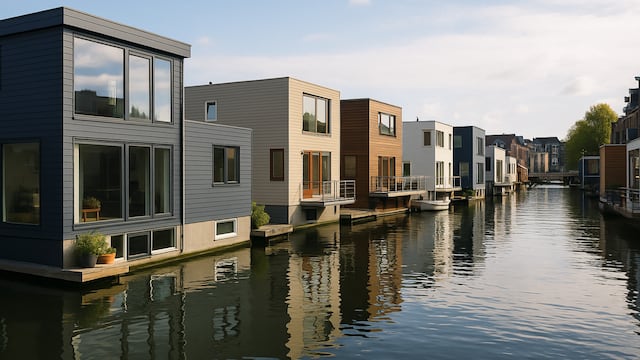Rising sea levels are a threat to many who live nearby, but maybe not if they move from its side to on top.

Could floating homes be the solution to massive flooding and climate change? They think so in the Netherlands

Given that the Dutch landscape is used to fighting water, one question that seems to have grown in popularity over the years is: what if we moved with it instead? In the appropriately named low-lying Netherlands – where around two-thirds of it would flood without dikes – engineers and architects are building homes that don’t battle against rising water, but on it.
Adaptive architecture: homes that rise with the tide
Floating and amphibious houses are designed to cope with flooding rather than simply defend against it. According to the European Environment Agency’s Climate-ADAPT database, these types of homes – floating on water or anchored to allow vertical motion – “are very effective in dealing with floods.”
For example, near the river Maas in the Netherlands a demonstrator site of floating and amphibious homes proved their worth when the river flooded in 2011: the homes rose and then settled back when water receded.
Why are the Netherlands leading the way on floating homes?
There are several factors making the Netherlands a natural testbed for this idea:
- Land is scarce and expensive, especially in canal-rich cities, so using water surface for housing is an attractive upgrade
- The Dutch have a long history of water management and are accustomed to engineering solutions for floods
- Climate change is intensifying flood and sea-level risk globally and home-living solutions that adapt rather than resist are gaining traction
There are a number of real-world examples of this. In the Dutch capital, the floating neighbourhood of Schoonschip in Amsterdam, as reported on by the Washington Post, is perhaps the most visible: floating homes connected to utilities, energy-smart, and built to rise and fall with water levels. Meanwhile the firm Waterstudio has completed over 200 floating homes across the country, applying the idea beyond one prototype.
Are floating homes the right approach?
The upside is clear: flexibility, flood-resilience, and better use of urban water surfaces. Floating development is seen as a promising adaptation in flood-prone, densely populated cities. But challenges remain: infrastructure connections (utilities, sewage, anchoring) are more complex. Regulatory frameworks must evolve because many building codes were made for land-based construction.
Scaling up remains an open question. While the Dutch examples show proof of concept, exporting the idea to major coastal megacities or low-income flood zones means dealing with cost, local regulations, and ecosystem impacts. As one analyst put it: for areas where land-based defences are reaching their limit, floating homes offer another line of thought. As COP30 continues in Brazil, adaptation is one of the key discussion points in the quest to prevent further pain and misery of those affected.
Related stories
Get your game on! Whether you’re into NFL touchdowns, NBA buzzer-beaters, world-class soccer goals, or MLB home runs, our app has it all.
Dive into live coverage, expert insights, breaking news, exclusive videos, and more – plus, stay updated on the latest in current affairs and entertainment. Download now for all-access coverage, right at your fingertips – anytime, anywhere.
Complete your personal details to comment